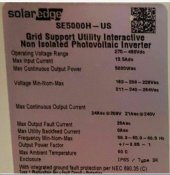Magallanes
New Member
- Joined
- May 9, 2020
- Messages
- 1
Greetings!!
I have an "off-grid" system running two paralleled MPP LV2424 with 3 (16kw) Tesla Model S modules energizing a subpanel, and two arrays with 7 panels each (14 total) installed. I just bought a SolarEdge SE6000H-US HD Wave, looking to install a system for net metering using the in-place arrays, effectively removing them from the off-grid system design. I am leaving the LV2424s/Batteries in place, as they are already "ac coupled" to the main panel.
I am looking into the SOLAREDGE POWER OPTIMIZER P730 with the intention of combining two panels (325w e/a) per optimizer. However my doubts are regarding a comment to the fact that those optimizers are only used on 3ph systems. Can anyone shed some light on this? Is there a specific optimizer that you guys recommend? Thanks!!
I have an "off-grid" system running two paralleled MPP LV2424 with 3 (16kw) Tesla Model S modules energizing a subpanel, and two arrays with 7 panels each (14 total) installed. I just bought a SolarEdge SE6000H-US HD Wave, looking to install a system for net metering using the in-place arrays, effectively removing them from the off-grid system design. I am leaving the LV2424s/Batteries in place, as they are already "ac coupled" to the main panel.
I am looking into the SOLAREDGE POWER OPTIMIZER P730 with the intention of combining two panels (325w e/a) per optimizer. However my doubts are regarding a comment to the fact that those optimizers are only used on 3ph systems. Can anyone shed some light on this? Is there a specific optimizer that you guys recommend? Thanks!!



